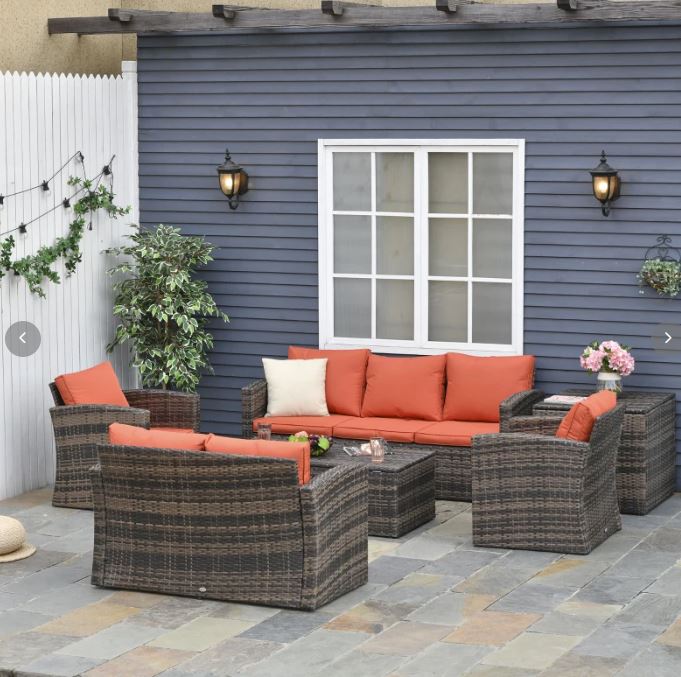In recent years, Polyrattan has emerged as a trendy and practical choice for garden furniture, revolutionising outdoor spaces with its elegance and durability.
Polyrattan: The Innovative Fiber of Today
Polyrattan, a generic term, signifies a synthetic plastic fiber and wickerwork material modeled after natural rattan.
Unlike its organic counterpart, Polyrattan lacks pores, thereby impeding liquid penetration and reducing vulnerability to UV damage.
This inherent resistance safeguards furniture against weather-induced deterioration and simplifies upkeep.
Beyond this pivotal deviation, Polyrattan mirrors numerous qualities of natural rattan. Thanks to contemporary technological advancements, distinguishing between Polyrattan and its natural counterpart proves increasingly challenging.
- Polyrattan: A polymeric fiber, known for its high resistance, often more durable than natural Rattan.
- Natural Rattan: Derived from palm trees, known for its solidity and flexibility, and ability to withstand sun exposure and weather conditions.
Comparative Advantages:
- Increased resistance to weather elements.
- Lower price point compared to natural Rattan.
- Eco-friendly and recyclable.
-
Color Options: Polyrattan is available in a wide range of colors, allowing for greater customization and coordination with different design schemes compared to natural rattan, which typically comes in natural hues.
-
Weight: Polyrattan is typically lighter in weight compared to natural rattan, making it easier to move and rearrange furniture pieces as needed.
Key Takeaway: 💡 Polyrattan stands out as a technologically advanced and more durable alternative to natural Rattan, offering great value and sustainability, which makes it a smart choice for outdoor furniture.
Advantages of Rattan and Polyrattan
Both Rattan and Polyrattan bring a wealth of benefits to the table, especially when it comes to outdoor furniture. From production to consumer use, these materials stand out for their eco-sustainability and durability.
-
Key Benefits:
- Eco-Sustainability: Polyrattan is almost entirely eco-sustainable.
- Durability: Unmatched resistance to weather and wear.
- Market Popularity: High commercial success due to these advantages.
-
Solidity and Resistance:
- Unparalleled in terms of weather resistance.
- Resilient against UVA and UVB sunlight, sea salt, and chlorine.
Key Takeaway: 💡 The combination of eco-friendliness and durability makes Rattan and Polyrattan a superior choice for consumers, aligning with the current trend towards sustainable yet stylish outdoor living as highlighted in our ultimate guide to buying rattan garden furniture.
Eco-Sustainability of Rattan and Polyrattan
The sustainability aspect of Rattan and Polyrattan is a significant factor in their popularity.
Both materials reflect a commitment to environmentally friendly practices, from reduced polypropylene use to recycled content.
-
Sustainable Production Process:
- Reduction in polypropylene usage, minimizing oil dependence.
- Utilisation of recycled polypropylene in production.
-
Eco-Friendly Attributes:
- Non-degenerative over time.
- Free from toxic substance dispersion.
Key Takeaway: 💡 Choosing Polyrattan for garden furniture, such as rattan bistro sets, not only enhances outdoor spaces but also supports sustainable manufacturing practices, contributing positively to environmental conservation.
Conclusion
Polyrattan is more than just a material; it's a sustainable, durable, and stylish choice for modern outdoor furniture.
As we have seen, it offers numerous advantages over traditional materials, making it an ideal choice for anyone looking to enhance their garden or outdoor space. Embracing Polyrattan means investing in quality, sustainability, and style.
References and Further Reading
For those interested in exploring more about the world of Rattan and Polyrattan, numerous resources are available. From detailed guides on selecting the perfect outdoor furniture to understanding the nuances of these materials, there's a wealth of information at your fingertips.
Visit our blog for more insights, including how to choose outdoor commercial garden furniture, or feel free to contact us for personalised advice on making the best choice for your outdoor space.
FAQs about Plastic and Polyrattan Garden Furniture
-
How durable is plastic and polyrattan garden furniture compared to other materials?
Plastic garden furniture has seen significant improvements in durability over the years due to advancements in materials. While it is generally affordable and easy to care for, it's essential to note that some concerns about longevity still persist. Polyrattan, on the other hand, is designed to mimic natural rattan but is made from mineral oil, offering a balance of affordability and durability. -
What are the main materials used in plastic garden furniture?
Plastic garden furniture is commonly made from materials such as polypropylene, polyrattan, polywood, and textilene. While these materials offer benefits like resistance to weather and insects, it's important to consider their environmental impact, as many are derived from fossil fuels. -
How does polyrattan compare to natural rattan in terms of sustainability?
While poly rattan serves as a cost-effective alternative to natural rattan and offers similar aesthetic qualities, it's crucial to recognize its composition primarily from mineral oil. This raises concerns regarding sustainability and environmental impact, particularly in the context of disposal and recycling. -
What are the drawbacks of plastic garden furniture?
Despite their affordability and resistance to weather, plastic garden furniture may heat up significantly on warm days and can be prone to brittleness and fading over time. Additionally, they require careful handling, especially concerning substances like oil or fat, which can cause stubborn stains. -
Is plastic garden furniture environmentally friendly?
While plastic garden furniture is lightweight, weather-resistant, and relatively durable, it's important to weigh its environmental impact. The production and disposal of plastic furniture raise concerns about sustainability and contribute to plastic pollution. Considering alternatives or opting for recycled plastic materials can mitigate some of these environmental concerns.

